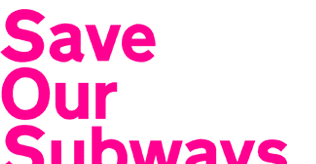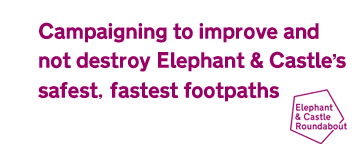









TfL's propose to fill in all seven subways. Elephant and Castle's safest, fastest footpaths would be lost forever. Pedestrians will be forced to share the street with motorised traffic, to wait patiently at traffic lights before they cross the dual carriageways - increasing their journey time here by 10% according to TfL's modelling data. Pedestrians will have to brave the wind tunnels, noise and swirling fumes, to pass through yet another busy road junction rather than delight in renovated and improved distinctive subterranean foothpaths, an historic landscape from a time when town and transport planners looked forwards not backwards. Let's not lose a pioneering 20th century space dedicated to pedestrians. Perhaps we could even build better subways, bigger, wider, lighter, filled with useful retail and recreation space?
This campaign believes the subways are at risk because of some bad processes and unfortunate misunderstandings:
1. There has been no consultation with local residents and regular users of the subways in the early planning stages of redesigning the roundabout. The two large blocks on the roundabout have been excluded from Elephant's stakeholder meetings. The proposed consultation in 2014 includes little opportunity for substantial changes.
2. TfL research shows significant use of subways and a detrimental effect on journey time of replacing them with surface level crossings.
3. Planners have a naive trust that pedestrians obey traffic lights - in the UK they often don't.
4. Politicians have made the assumption that their voters want the subways to go. It was obvious at February 2014's Community Council meeting for the local area that this assumption is wrong. A vote revealed a 50:50 split and many abstensions.
5. 'Shared space' has become fashionable and misunderstood in urban design and 1950s urban planning has become unfashionable and caricatured as being all about cars not pedestrians.
6. The subways' are poorly maintained and very poorly signposted. Bulbs are blown, the ground is cracked, the filth is engrained. This makes them unnecessarily dirty, dark and confusing. This shouldn't condemn them to demolition.
7. Marketing the Elephant and Castle is motivating the removal of the subways. It's about image, it's not about practicality. We quote the EC Programme Risk Log Oct 2012: "Proposed improvements to northern roundabout will remove last of pedestrian subways changing perceptions and reputation".
8. An organised and vocal cycling lobby in London sometimes unfortunately distract from the issue of pedestrian well-being. They may not be opposed to pedestrian subways but they inevitably emphasise improving street level safety rather than advocating subways. Pedestrian subways are only ocassionally suited to cyclists as well, such as renovated crossings just east of the Elephant and Castle beneath the New Kent Road and Old Kent Road.
9. Since Stanley Kubrik's 1971 film of Clockwork Orange pedestrian subways (filmed in Wandsworth) subways have been used as backdrops for portraying criminalty and modern decay. Here's a particularly horrible incident in a subway in 2009's Harry Brown (filmed in Essex). As badly lit, badly signposted places subways can create an environment of fear.
The plans for the roundabout have been developed during 2012 and 2013 behind almost entirely closed doors with no public consultation in advance. The roundabout has only been formally publically discussed in public at a Community Forum in July 2012. It was just one agenda point in a larger meeting. A glossy computer generated video from TfL was shared to a small gathering of locals who were lucky enough to discover the meeting was happening. It was widely ridiculed by the audience as nonsense - a fantasy Telly Tubby land almost entirely free of motorised traffic despite TfL's assertion that evening that the redesign must continue to accomodate today's volume of vehicles! Despite requests to share the video with the wider public the lavish production remains outside the public domain. Since then two different proposals have emerged, the most recent in February 2014.
The attitudes to the advantage and disadvantages of the current network of underground footpaths has instead been gathered by a small group of senior management from local commercial and educational premises and property developers. The voice of local residents has not been sought and this campaign fears they will only be invited to participate too late in the process for any really significant changes to be made.

© Save Our Subways 2012 - 2014